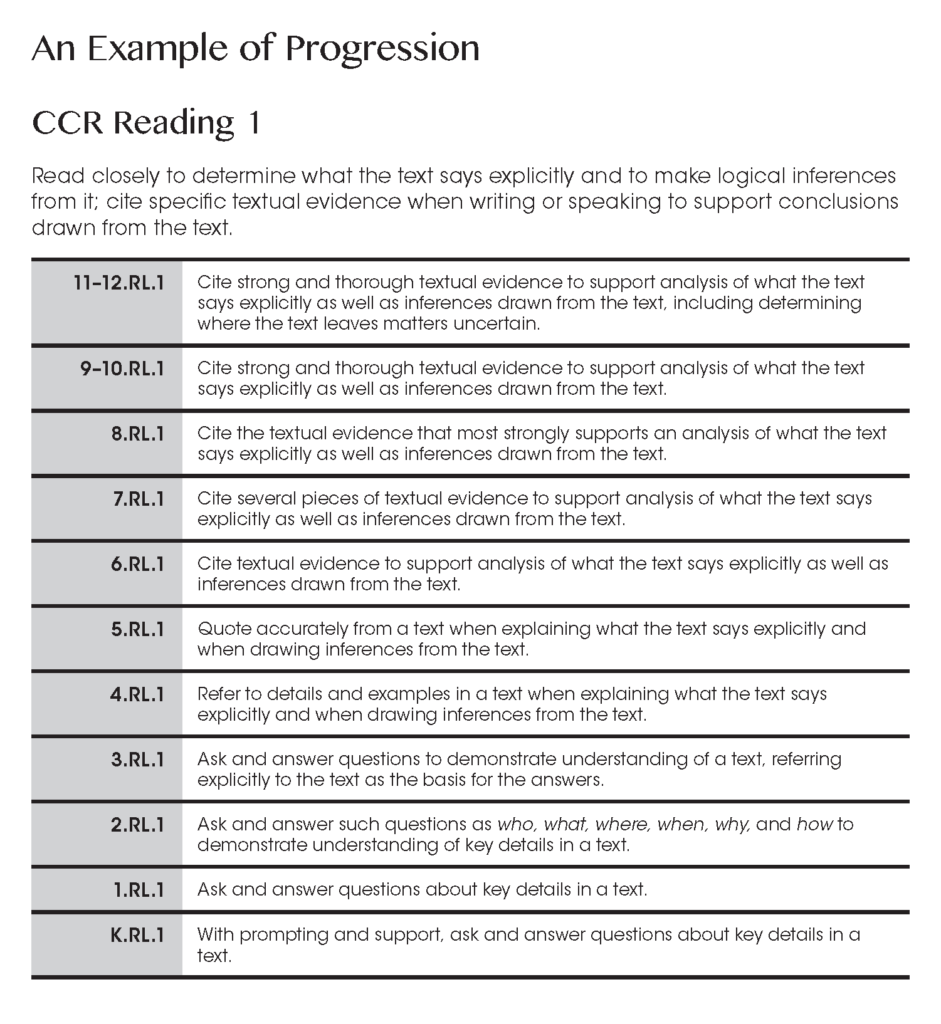Share this article.
It is well known that the Common Core State Standards for English Language Arts and Literacy in History/Social Studies, Science, and Technical Subjects provide a common set of standards that when met will develop college and career ready students. (National Governors Association Center for Best Practices & Council of Chief State School Officers, 2010)
But, did you know that they also provide a framework for teachers to develop integrated literacy scopes and sequences, integrated literacy units and integrated literacy lessons that support conceptual redundancy of the skills within the standards that leads to mastery? How do they do that?
A key design consideration was the focus on results rather than means with the ultimate being career and college ready students. Therefore, the standards were judiciously selected and carefully organized into a structure that is patterned, parallel, and progressive from kindergarten to high school. It is these patterns, parallels, and progressions that seamlessly lend themselves to integration.
As mentioned in another article, integration is crucial for delivering efficient instruction that aids students in developing the skills to gather information from text, think critically about that information, and produce their thinking around the information. That’s why we’ve presented a series of articles to provide the necessary support for analyzing those patterns, parallels, and progressions, along with the tools required to construct your own integrated literacy units and lessons.
This article delves into the structure of the learning progressions for each standard from kindergarten through high school and how teachers can leverage these progressions to focus instruction on the skills specific to their grade level, make connections to what was previously taught, and build a foundation for what is to come.
Let’s go…
Anchor Vs. Grade-Specific Standards
The authors started writing the literacy standards by beginning with the end in mind. The College and Career Readiness (CCR) standards were developed first. These CCR standards define the ultimate expectations in each strand and anchor the grade-specific standards. These standards define the end-of-year expectations and are structured to build on each other from kindergarten to the CCR. (National Governors Association Center for Best Practices & Council of Chief State School Officers, 2010)
There are 32 Career and College Readiness standards, ten for Reading, ten for Writing, six for Speaking and Listening, and six for Language. Each CCR anchor standard has a corresponding grade-level standard that translates the CCR into grade-appropriate skills. The only caveat is that there are 20 reading standards for each grade level (ten for literature and ten for informational text) which share the same 10 CCR standards. And, the anchor standards for Reading and Writing also apply to the standards for history/social studies, science, and technical subjects.
Clear Learning Progressions
With the CCR standards serving as the ultimate goal, the grade-level standards were intentionally crafted as a clear and cumulative path from kindergarten to college and career readiness.
“The standards for college and career readiness then became the anchor standards for the entire program. The standards writers developed a careful sequence or ‘staircase’ as they called it, of corresponding grade-level standards that would lead students to the standards for college and career readiness.
In doing so, the standards writers paid careful attention to learning progressions. In recent years, research and practitioners have outlined models that describe the knowledge and skills within a subject area and the sequence in which they typically develop over time.” (Rothman, 2011)
This sequence or staircase of learning is not readily apparent in the published standards as that document is organized by grade-level and content-area. But, when the standards are organized by the literacy strand and standard number the clear learning progressions from kindergarten to the career and college ready anchor standard are hard to miss.
Take a look at this progression for CCR Reading 1 in Literature…
As you can see, CCR Reading 1 expects a college and career ready student to be able to determine what a text says explicitly, make logical inferences from what the text says, and cite specific textual evidence to support conclusions drawn from the text. In order to meet those expectations, the learning progression of those skills suggest Kindergarten, Grade 1, Grade 2, and Grade 3 students master varying degrees of being able to ask and answer questions to demonstrate understanding of key details in a text. This mastery prepares students for Grades 4 and 5 where the new skills of quoting details and making inferences are introduced. These are the foundations that Grades 6-12 can build on to ensure students master varying degrees of citing textual evidence to support analysis and inferences.
And, again this learning progression is not an anomaly. There are 31 other “staircases” of learning on the way to career and college readiness.
Leveraging Learning Progressions Develops Learnership
Imagine if your grade level, your school, and your district leveraged these progressions. By clearly articulating not just each grade’s expectations, but also understanding where those skills fit in the learning sequence you would benefit from the collective responsibility of thirteen years to be college and career ready. By connecting previous and future learning in the progression you would be ensuring the integration and conceptual redundancy of the skills students need to be college and career ready.
So, start looking at the standards in a new way and determine where your grade-level fits in the learning progression. Then check out the other articles in this series to build your learnership around:
- How the patterns in the standards can help students and teachers.
- How to use the patterns to determine measurable and achievable skills within the standards.
- How to utilize the correlations between the strands of literacy to support integration, conceptual redundancy, and mastery.
- How to build integrated literacy units.
Continue the Learning
Check out these articles and resources to continue your learning about this topic…
The Learning Brief
In this article you learned…
- The authors of the literacy standards wrote the standards with the end in mind by starting with the College and Career Readiness (CCR) standards, which define the ultimate expectations in each strand and anchor the grade-specific standards.
- With the CCR standards serving as the ultimate goal, the grade-level standards were intentionally crafted as a clear and cumulative path from kindergarten to college and career readiness.
- How teachers can leverage these progressions to focus instruction on the skills specific to their grade level, make connections to what was previously taught, and build a foundation for what is to come.
Can you imagine building an environment full of motivated, engaged, and eager students who own their learning?
We can.


